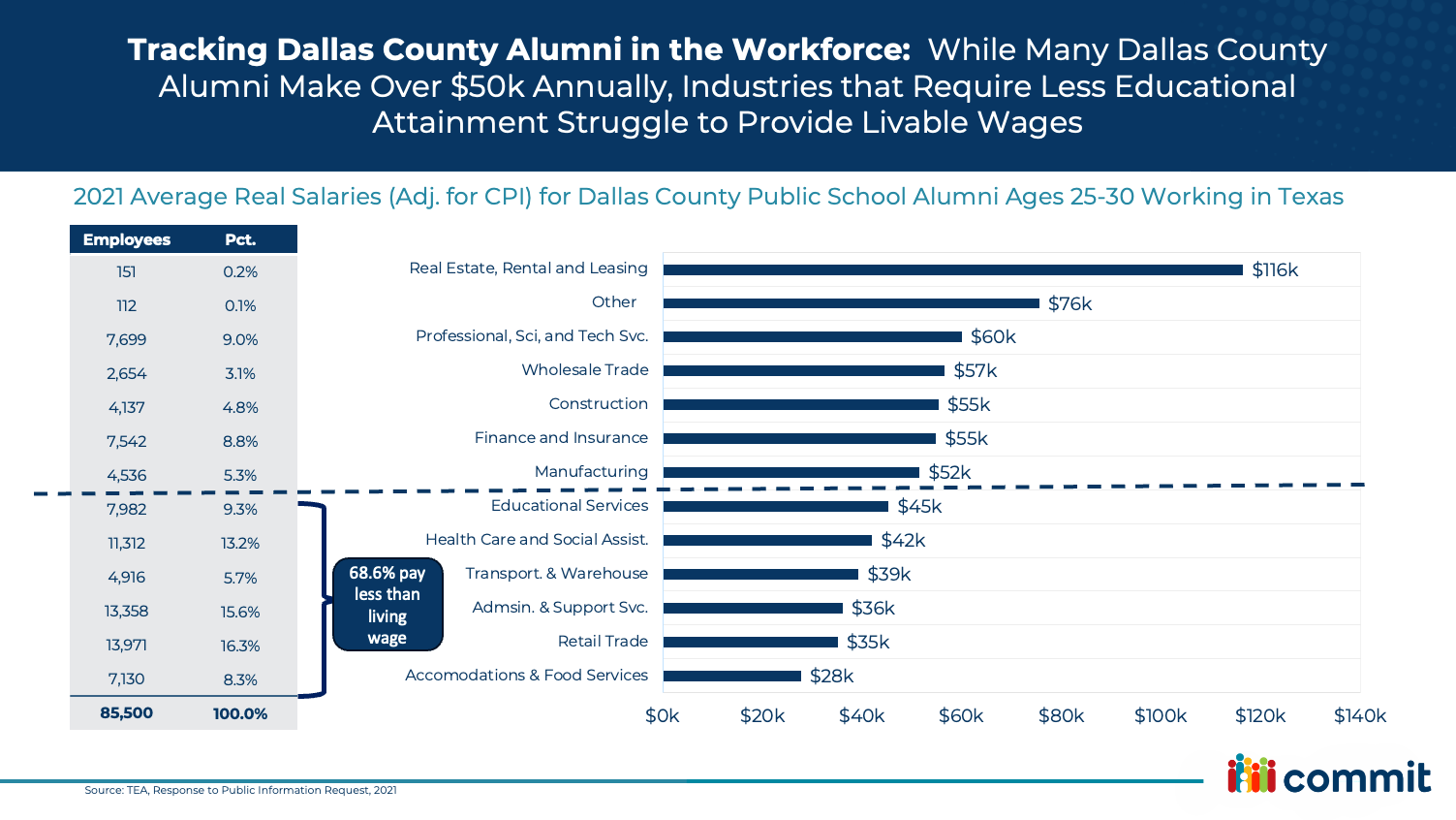Years of data have made clear that educational attainment, the highest level of education an individual receives, is one of the strongest factors determining lifetime earning potential. This means the plans graduating seniors make for their next six years profoundly impact their ability to earn a living wage, enough money to support themselves and potentially families of their own.
The Goal
The Commit Partnership calculated a living wage in 2021 was $54,636 a year (see our Methodology for more information on how this is calculated and updated yearly). The good news is that for Dallas County public school alumni between the ages of 25-30 who have at least associate degrees, the average wage in 2021 was $58,700, putting them above the current living-wage level.
The Challenges
In that same age group, however, for those without any college the average salary was $37,100. That’s a $21,600 difference in average annual income.
In fact, only 13 percent of young adult Texans without associate degrees earn salaries that meet the living wage standard. Those who obtain associate degrees are nearly twice as likely to earn a living wage than those without. Students who obtain bachelor’s degrees significantly increase their chances of earning enough to support their households, making them four times as likely to earn living-wage level salaries than those with no college at all.
Despite this correlation, postsecondary enrollment continues to decline, especially among young men.

Between 2007 and 2016, schools in Dallas County increased the portion of eighth graders who went on to graduate from high school from 63% to 81%. While that meant the class of 2016 earned thousands more diplomas, that didn't necessarily translate into more students going on to earn a living wage. Texas continues to create jobs at a rapid pace, but most of the new jobs require some type of postsecondary education.
That’s why it’s especially troubling that the number of young Texas enrolling in two- and four-year higher education institutions declined 18 percentage points between 2012 and 2020.
Data provided by Dallas County Promise, a nonprofit coalition that supports postsecondary education, on the plans of 2024 high school seniors indicates that out of 22,031 students surveyed, less than three quarters plan on pursuing two- or four-year degrees. While 512 are opting to join the military, of the 1,754 planning to get certifications or attend technical school, over two thirds are male. A similar percentage of the 1,074 students planning to go straight to work are also male.
While any postsecondary attainment is advantageous in the workforce, the full impact of this advantage depends on the field of study. In Dallas County, industries that require less educational attainment struggle to pay salaries at a living wage level. Analysis of the average salaries of Dallas County public school alumni between the ages of 25-30 working in Texas in 2021 shows that nearly 70% were paid less than the living wage standard. The study also indicated that approximately 22% more would soon fall below that threshold without cost-of-living adjustments to their salaries.

Dallas County Promise surveyed seniors participating in the Promise Path education guidance program on their post-graduation plans. Of 20,917 seniors surveyed in 2023 (excluding the 2,961 who marked “not sure yet,”), the first choices of nearly 40% were careers that currently do not pay living-wage level salaries.
While more female students are attaining postsecondary education than males, these degrees and certifications can tend to be in areas of study in which the current workforce struggles to earn living wage level salaries. Meanwhile, male students who attain postsecondary credentials have a higher chance of attaining living wage level salaries than women do, but fewer men are choosing to do so. In other words, the Dallas County education system is not adequately meeting the needs of more than two-thirds of the people entering the workforce.
The Opportunities
Fortunately, the Texas Legislature recently provided tools to help our public education system send more kids to college and postsecondary training.
House Bill 8 (88R) transformed funding for Texas community colleges by expanding college capacity, improving affordability for students and incentivizing positive student outcomes through outcomes funding for credential attainment aligned with state workforce needs. Combined with over $144 million of potential outcomes funding for Dallas County public school districts made possible by House Bill 3 (86R), these two landmark policies can act as tremendous catalysts to accelerate continuous improvement in the high school to workforce space and allow more of our own students to participate in the robust economic opportunity found within our region.
The challenges mentioned above remain, including the disparities between different demographics and industries, but Texas has taken big steps toward making postsecondary education and certification more attainable for high school graduates.




